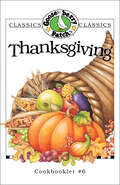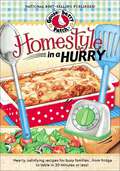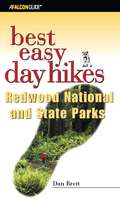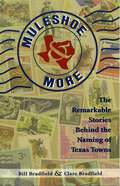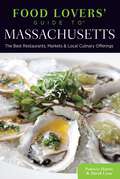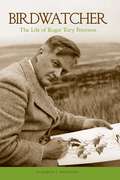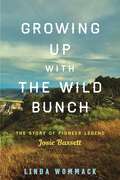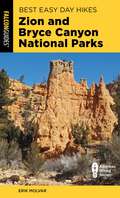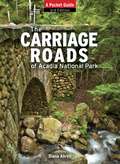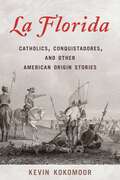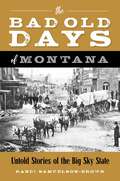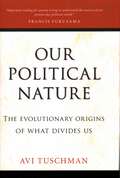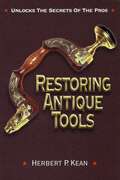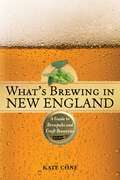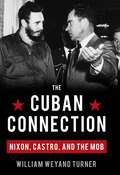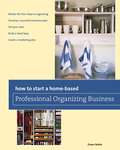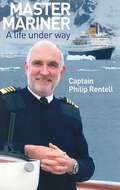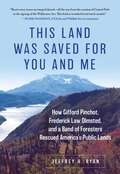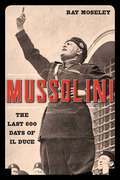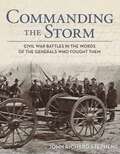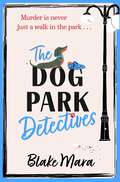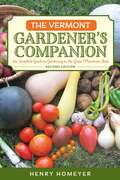- Table View
- List View
Thanksgiving Cookbook
by Gooseberry PatchGet a taste of Gooseberry Patch in this collection of over 20 favorite Thanksgiving recipes! Thanksgiving celebrates the feast of all feasts with roast turkey & gravy, vanilla-glazed sweet potatoes, harvest apple cheese cake and more.
Homestyle in a Hurry
by Gooseberry PatchIn the newest title in the best-selling Gooseberry Patch cookbook series, they've gathered recipes that are ready in 30 minutes or less...but with homestyle taste too! With over 200 recipes for satisfying comfort food, Homestyle in a Hurry features breakfast & brunch dishes to get the family out the door on time and with full bellies. Pressed-for-time cooks will also love the hearty main dishes that you can make from what's always in the pantry plus appetizers, soups and sides that are all ready in a jiffy. Each page also includes a time-saving tip or idea for simplifying meal-planning, entertaining, decorating and more.
Best Easy Day Hikes Redwood National and State Parks (Best Easy Day Hikes Series)
by Daniel BrettRedwood National and State Parks are home to some of the world's tallest trees: old-growth coast redwoods, living to be 2000 years old and growing to over 300 feet tall. Author and hiker Dan Brett includes trail descriptions and maps of nearly 22 easy day hikes within these spectacular parks. This indispensible guide provides accurate hike descriptions, easy-to-follow maps, and concise trail information for the author's favorite trails.
Muleshoe and More: The Remarkable Stories Behind the Naming of Texas Towns
by Bill Bradfield Clare BradfieldThis book discloses the humorous and the sometimes controversial, if not curious, circumstances surrounding the naming of more than 700 Texas towns.
Food Lovers' Guide to® Massachusetts: The Best Restaurants, Markets & Local Culinary Offerings (Food Lovers' Series)
by David Lyon Patricia HarrisThe ultimate guide to the food scene in Massachusetts provides the inside scoop on the best places to find, enjoy, and celebrate local culinary offerings. Written for residents and visitors alike to find producers and purveyors of tasty local specialties, as well as a rich array of other, indispensable food-related information including: food festivals and culinary events; specialty food shops; farmers&’ markets and farm stands; trendy restaurants and time-tested iconic landmarks; and recipes using local ingredients and traditions.
Birdwatcher: The Life of Roger Tory Peterson
by Elizabeth Rosenthal[2015 Reprint] Roger Tory Peterson—the Renaissance man who taught Americans the joy of watching birds—also invented the modern field guide. His 1934 landmark Field Guide to the Birds was the first book designed to go outdoors and help people identify the elements of nature. This self-proclaimed &“student of nature&” combined spectacular writing with detailed illustrations to ultimately publish many other books, winning every possible award and medal for natural science, ornithology, and conservation. Birdwatcher is a comprehensive, illustrated biography of Roger Tory Peterson--a hero in the conservation world--including interviews with friends, family, and protégés.
Growing Up with the Wild Bunch: The Story of Pioneer Legend Josie Bassett
by Linda WommackThe life of Josie Bassett was nothing short of a female pioneer adventure. Josie came west in a wagon train at the age of four. Settling in rugged Brown's Park in the extreme northwest corner of Colorado, Josie learned to ride and rope by the age of six. Like all girls, as a young teenager she discovered boys, but Josie's first real boyfriend was a future outlaw, none other than Butch Cassidy. As a young rancher's wife with two young boys, Josie witnessed first-hand the strong-arm tactics of the cattle barons trying to steal the land from smaller ranch owners. When it happened to the Bassett family, Josie's husband and father fought back. Murder occurred at the ranch when a man was hung from the gate post at the entrance of the Bassett ranch.Following a bitter divorce and a few more marriages, Josie moved to the remote area of Cub Creek in western Utah. Here she managed to make a living by hunting, making moonshine and possibly cattle rustling. (She was brought up on charges but acquitted.) Josie married a few more times, running off one husband with a frying pan. He later said, &“Josie gave me fifteen minutes to get off her land, I only needed five!&”Josie was the feature of a LIFE magazine article in 1948 and was a rodeo queen when she was in her 70s. Josie Bassett lived a long adventurous life, dying in 1963.
Best Easy Day Hikes Zion and Bryce Canyon National Parks (Best Easy Day Hikes Series)
by Erik MolvarCompletely updated and revised, this third edition of Best Easy Day Hikes Zion and Bryce Canyon National Parks features concise descriptions and easy-to-follow maps for twenty-two easily manageable hikes.Eric Molvar describes the best routes for those who have limited time or abilities, without missing out on the area&’s scenic splendors.Look inside for:Half-hour strolls to full-day adventures Hikes for everyone, including families Hikes ranked from easiest to more challenging GPS coordinates for trailheads
The Carriage Roads of Acadia: A Pocket Guide
by Diane AbrellWith more than 45,000 copies sold this is one of the most popular books ever published about Acadia National Park. Its small size and useful format make it the perfect book to pick up if you are interested in exploring the park. Densely packed with maps and easy to use directions as well as wonderful descriptive information about each walk/hike/bike-rid, this 3rd edition also contains a new foreword by Andrew Vietze providing history of the carriage roads.
Florida: Catholics, Conquistadores, and Other American Origin Stories
by Kevin KokomoorLa Florida explores a Spanish thread to early American history that is unfamiliar or even unknown to most Americans. As this book uncovers, it was Spanish influence, and not English, which drove America&’s early history. By focusing on America&’s Spanish heritage, this collection of stories complicates and sometimes challenges how Americans view their past, which author Kevin Kokomoor refers to as &“the country&’s founding mythology.&” Dig deeper into Hispanic and Caribbean history, and how important happenings elsewhere in the Spanish colonial world influenced the discovery and colonization of the American Southeast. Follow Spanish sailors discovering the edges of a new continent and greedy, violent conquistadors quickly moving in to find riches, along with Catholic missionaries on their search for religious converts. Learn how Spanish colonialism in Florida sparked the British&’s plans for colonization of the continent and influenced some of the most enduring traditions of the larger Southeast. The key history presented in the book will challenge the general assumption that whatever is important or interesting about this country is a product of its English past.
Bad Old Days of Montana: Untold Stories of the Big Sky State
by Randi Samuelson-BrownThe Bad Old Days of Montana celebrates the state&’s glorious and rowdy past. Many people born and bred here relish just how &“bad&” things used to be: the terrain, the inhabitants and especially the quality of whiskey. It almost goes without saying that Montana had all the characteristic wild west elements — and in abundance! The chapters focus on the infamous and notorious rather than the law-abiding and civic-minded settlers. These pages, like the state, recount the tales of people who came west seeking if not their fortune, at least opportunity. It is no secret that Montana was settled by the adventurous willing to brave the harsh conditions and to prevail. Whether on the right or the wrong side of the law, all settlers and pioneers made unique contributions to the state&’s complex culture. Certainly, in the nineteenth century, Montana was not for the faint of heart.Beginning with the Lewis and Clark Expedition of 1804 as the origins of the mountain men, the book will offer a variety of strange tales, ranging from vigilanteeism to the heyday of the Copper Kings. Many such tales were influenced by too much whiskey and greed. This book is an account of the misfits, outlaws and rugged individuals who cast their mark on this most remarkable state. Populated by the native tribes before &“discovery&” by Lewis and Clark at the headwaters of the Missouri River, the land that would become known as Montana was traversed by mountain men, mined by gold and mineral seekers and ranched and harvested by the homesteaders. Throughout these varied waves of discovery and settlement, this book explores the less-than-savory dealings, the early attempts at law and order (which often failed or had questionable results), and the myriad of colorful characters and events that made Montana what it is today.
Our Political Nature: The Evolutionary Origins of What Divides Us
by Avi TuschmanThe first book to tell the natural history of political orientations. Our Political Natureis the first book to reveal the hidden roots of our most deeply held moral values. It shows how political orientations across space and time arise from three clusters of measurable personality traits. These clusters entail opposing attitudes toward tribalism, inequality, and differing perceptions of human nature. Together, these traits are by far the most powerful cause of left-right voting, even leading people to regularly vote against their economic interests. As this book explains, our political personalities also influence our likely choice of a mate, and shape society's larger reproductive patterns. Most importantly of all, it tells the evolutionary stories of these crucial personality traits, which stem from epic biological conflicts. Based on dozens of exciting new insights from primatology, genetics, neuroscience, and anthropology, this groundbreaking work brings core concepts to life through current news stories and personalities. For instance, readers will meet Glenn Beck and Hugo Chavez and come to understand the underlying evolutionary forces they represent. By blending serious research with relevant contemporary examples,Our Political Naturecasts important light onto the ideological clashes that so dangerously divide and imperil our world today.
Big Yoga
by Meera Patricia KerrWinner of the IBPA Benjamin Franklin Award for Best Health TitleIf you think yoga is only for skinny young things, you need to think again. To expert Meera Patricia Kerr, yoga can and should be used by everyone—especially plus-size individuals. In her new book, Big Yoga, Meera shares the unique yoga program she developed for all those who think that yoga is not for them.Part One of Big Yoga begins with a clear explanation of what yoga is, what benefits it offers, and how it can fit into anyone&’s life. Included is an important discussion of selfimage. The book goes on to provide practical information regarding clothing, mats, and suitable environments, and to emphasize the need to begin with care.Part Two offers over forty different exercises specifically designed to work with bigger bodies. In each case, the author explains the technique, details its advantages, and offers step-by-step instructions along with easy-to-follow photographs. If you have thought that yoga is not for you, pick up Big Yoga and let Meera Patricia Kerr help you become more confident and relaxed than you may have ever thought possible.
Restoring Antique Tools
by Herbert P. KeanHere is the book that finally unlocks the secrets that professional restorers have been using for years. It explains critical (and previously closely-held) restoration techniques in a way that even the most uninitiated can understand and follow, giving the reader confidence throughout and making the art of restoration not only extremely remunerative for the collector, but satisfying and fun as well. There are chapters covering all the categories of tools, as well as a general chapter on cleaning and refinishing. The author explains how to make a bow for a bow drill, how to tighten loose heads on Sheffield and Ultimatum braces, how to make wedges for planes, how to replace vials in levels, how to repair chipped or missing threads on a plow plane, and literally hundreds of other such invaluable instructions.
475 Tax Deductions for Businesses and Self-Employed Individuals: An A-to-Z Guide to Hundreds of Tax Write-Offs
by Bernard B. KamoroffAre you paying more taxes than you have to? The IRS is certainly not going to tell you about a deduction you failed to take, and your accountant is not likely to take the time to ask you about every deduction you&’re entitled to. As former IRS Commissioner Mark Everson admitted, &“If you don&’t claim it, you don&’t get it. That&’s money down the drain for millions of Americans.&” This invaluable book, updated to reflect changes in tax law, not only lists the individual items that are deductible—from Internet domain name costs to theft losses—but also explains where to list them on your income tax form. &“Tax law isn&’t easy,&” the author explains, &“but this book is.&” The twelfth edition will be completely updated to include new changes in tax law, a chapter on home-based businesses, and include a special &“jump out&” highlights in the A-to-Z listings for any deduction that has special rules for home-based businesses.
What's Brewing in New England: A Guide to Brewpubs and Microbreweries
by Kate ConeThe Northeast has experienced an explosion of microbreweries and brew pubs producing a fascinating array of beers from IPAs to stouts, lagers, and porters. The number of microbreweries has grown by leaps and bounds since the first edition of this guide was published nearly twenty years. Now, Kate Cone has traveled the length and breadth of the region to both research the breweries profiled in the first edition and the newcomers that have sprung up since, and of course to sample their products. The new volume includes interviews with the brewers, anecdotes and stories about the breweries and brewpubs, as well as directions, information about their hours of operation, their menus, and even some recipes. The breweries are not ranked, as beer preference is so subjective, but Cone does share her personal experiences and opinions. She covers every brewery in the region, so she's able to help you find the places, but it's up to you to determine which you like the best.
Cuban Connection: Nixon, Castro, and the Mob
by William Weyand TurnerIn April 1959, Fidel Castro toured the United States at the invitation of the American Society of Newspaper Editors. Though he was wary, Castro entertained some hope of establishing a rapprochement with Washington. But after being snubbed by President Eisenhower and receiving a less-than-cordial reception from Vice President Richard Nixon, Castro got the strong impression that US intentions toward his new Cuban government were hostile. In The Cuban Connection, former FBI agent and investigative journalist William Turner examines the fateful meeting between Castro and Nixon and the murky connections that existed between official Washington, the CIA, and organized crime in Cuba. Based on firsthand interviews with many of the key players involved in Cuban-American relations of that era, plus thorough background research, Turner raises a host of disturbing questions: Before the ouster of the Cuban dictator Fulgencio Batista by Castro, why did Vice President Nixon often socialize at Havana casinos with his Cuban friend Bebe Rebozo? How was the rabid anticommunism of the Eisenhower administration, especially its instant dislike of Castro, connected to its cozy relationship with the former mob-controlled dictatorship? How did all of this set the stage for the Bay of Pigs fiasco and ultimately the Cuban Missile Crisis and the JFK assassination? In a vivid narrative The Cuban Connection provides insider information that rarely reaches the public and that many in power never wanted the public to know.
How to Start a Home-based Professional Organizing Business (Home-Based Business Series)
by Dawn NobleFrom estimating start-up costs and finding clients to how to stay profitable even in slow economic climates, this book takes you through every aspect of setting up and running a thriving home-based professional organizing business. Whether you&’re just starting to explore your options for a home-based business or are an organizing wizard looking to be your own boss, each chapter will guide you on how to build your own successful organizing business. Look for useful charts and worksheets throughout the book, including:Start-Up Costs ChecklistClient Intake FormAssessment Visit/Working AgreementSample InvoiceMarketing Plan Worksheet
Master Mariner: A Life Under Way
by Philip RentellFrom his days as a cadet on the aging training ship Worcester, Captain Philip Rentell's forty-year career has spanned the world's oceans and a huge variety of seagoing experience. He served as a junior officer on numerous freighters and liners, as the navigator of cross-Channel hovercraft, and then as first officer of the Cunard flagship QE2, on which he went to the South Atlantic with over 3,500 British troops and a volunteer crew of 650 during the Falklands War of 1982. SInce leaving Cunard in 1990. he has been and English Channel and North Sea pilot, and has commanded a succession of cruise ships.
This Land Was Saved for You and Me: How Gifford Pinchot, Frederick Law Olmsted, and a Band of Foresters Rescued America's Public Lands
by Jeffrey H. RyanThe story of how America&’s public lands—our city parks, national forests, and wilderness areas—came into being can be traced to a few conservation pioneers and proteges who shaped policy and advocated for open spaces. Some, like Frederick Law Olmsted and Gifford Pinchot, are well known, while others have never been given their due. Jeffrey Ryan covers the nearly century-long period between 1865 (when Olmsted contributed to the creation of Yosemite as a park and created its management plan) to the signing of the Wilderness Act of 1964. Olmsted influenced Pinchot, who became the first head of the National Forest Service, and in turn, Pinchot hired the foresters who became the founders of The Wilderness Society and creators of the Wilderness Act itself. This history emphasizes the cast of characters—among them Theodore Roosevelt, Bob Marshall, Benton MacKaye, Aldo Leopold, and Howard Zahniser—and provides context for their decisions and the political and economic factors that contributed to the triumphs and pitfalls in the quest to protect public lands. In researching the book, Ryan traveled to the places where these crusaders lived, worked, and were inspired to take up the cause to make public lands accessible to all.
Mussolini: The Last 600 Days of Il Duce
by Ray MoseleyIn his last days, Mussolini, the tyrant, was in the grip of anger, shame, and depression. The German armed forces that had sustained his puppet government since its creation in September 1943 were being inexorably driven out of Italy, the frontiers of his Fascist republic were shrinking daily and Mussolini was aware that German military leaders were negotiating with the Allies behind his back in neutral Switzerland. Moseley's well-researched and highly engaging tome throws light on the last twenty months of the despot's life and culminates with the dramatic capture and execution of Mussolini (and his mistress Claretta Petacci) by partisans of the Italian resistance on April 28, 1945.
Commanding the Storm: Civil War Battles in the Words of the Generals Who Fought Them
by John Richard StephensFrom Beauregard and Custer to Lee and Sherman, twelve commanders from each side vividly describe what they and their men experienced at twelve of the war’s most legendary battles from Fort Sumter to Appomattox Court House in accounts gathered from letters, memoirs, reports, and testimonies. They relate noted incidents and personal triumphs and tragedies while covering strategies and explaining battlefield decisions. Trench warfare at Petersburg and Sherman’s scorched earth policy in Georgia foreshadowed the world wars to come, and technological advancements—such as armored steamships, landmines, and machine guns—literally changed the landscape of war. Submarines and a time bomb even came into play. Informative biographies and headnotes for each battle give parallel statistics at a glance and establish context; sidebars cover notable tactics and technologies, including espionage, aerial reconnaissance, and guerilla warfare; and a concise roll-call outline each commander's life in full after the war. Here, from the men who conducted and controlled it, is an invaluable sourcebook of what happened in the War Between the States and why.
The Dog Park Detectives: Murder is never just a walk in the park . . . (Dog Park Detectives #1)
by Blake MaraMurder is never just a walk in the park . . . When friends Louise and Irina find a dead body in the local park whilst walking their dogs, they are soon drawn into the mystery of who murdered local entrepreneur Phil Creasey. Phil used to be a member of their dog walking community – nicknamed &‘the Pack&’ – until the death of his cockapoo, and the Pack feel they owe it to Phil to investigate his death. But with Louise and Irina leading the charge, it isn&’t long until they&’re neck-deep in local gangs, stolen motorcycles and a disturbing string of poisonings. Have the Pack bitten off more than they can chew, or can they follow their noses and solve the crime?The Dog Park Detectives is a joyous and fur-ociously entertaining murder mystery for fans of dogs and cosy crime, and the first in a pawfully exciting new series that is perfect for fans of Richard Osman and Robert Thorogood. &‘More good dogs than I've ever seen in a single book! Oh, and a grisly, puzzling murder to solve, with lots of twists and red herrings. But really, I'm here for the pooches, and you should be too&’ Antony Johnston &‘Howling good fun, with a plot twisty enough to get any dogged armchair detective barking up the wrong tree. I loved it – just don't tell my cats!&’ Fiona Leitch &‘Adored The Dog Park Detectives! Brilliantly written, with quirky characters, dogs and a dash of murder, I ripped through this in two sittings. Perfect cosy crime&’ Lisa Hall &‘A pacy and entertaining murder mystery that&’s a must-read for all dog-loving crime fans. Go the Dog Park Detectives!&’ A. K. Turner &‘Totally PAWSOME – I was hooked from the very first page and Mara weaves a special cosy magic throughout with rich characters and a fascinating, twisty plot. A brilliant whodunnit and all delivered with the deftest of touches. Unputdownable!&’ Jonathan Whitelaw, author of The Bingo Hall Detectives &‘An absolute delight to read. Like a lovely, summery stroll in the park - specifically the dog park&’ Kat Ailes, author of The Expectant Detectives &‘A fun murder mystery with plenty of leads to get tangled and clues to sniff out!&’ Sarah Yarwood-Lovett &‘I loved it. As someone allergic to furry animals, it was nice to hang out fictionally with "the Pack" as they sniffed out the evidence and did their best not to tangle up dog leads on their quest to find a murderer. With memorable owners and even bigger dog personalities, this series is set to run and run&’ Joy Kluver
Pennsylvania Made: Homegrown Products by Local Craftsman, Artisans, and Purveyors (Made in)
by Bernadette SukleyA unique guidebook and local resource full of hundreds of things to find and buy, crafts to discover, factories to explore, and history to uncover––all made in Pennsylvania. Hundreds of the state's top cottage industries––all places that you can shop and/or tour––are showcased. Organized by product type, categories include ceramics/pottery, clothing/accessories, furnishings/furniture, glassware, home décor, jewelry, specialty foods, toys/games, and so much more. Together, these homegrown establishments help make up the identity and fabric of the Key Stone State.
The Vermont Gardener's Companion: An Insider's Guide to Gardening in the Green Mountain State (Gardening Series)
by Henry HomeyerThe Vermont Gardener's Companion tells how to get the most out of Vermont&’s short gardening season and details how readers can use organic methods to improve soil, deal with diseases and pests, and get better results with their plants in a state where &“winter temperatures plunge far below zero and rocks left by the glaciers pop out of the ground each spring like bread from hyperactive toasters.&” With good humor and a natural teacher&’s gift for explanations, Henry Homeyer makes gardening fun and readily accessible to all.
